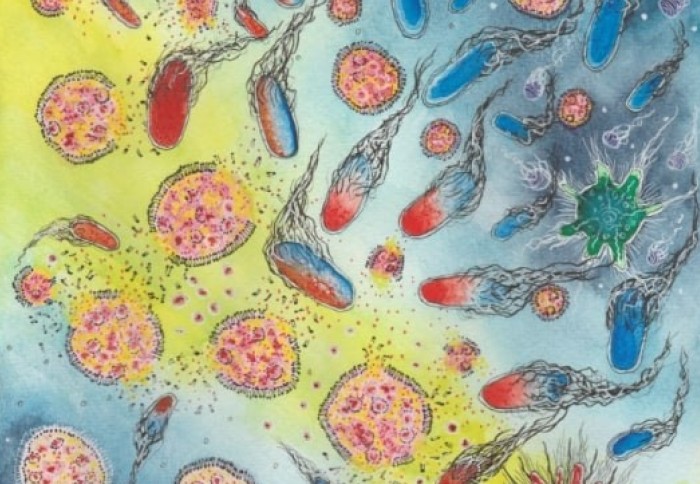Lab-grown cell machinery prompts real cells to sense and react to outside cues

Greta Zubaite
Imperial researchers have programmed bacterial cells to react to changes in light and temperature with the help of synthetic cell machinery.
The innovation is a step forward for the field of cell engineering – a discipline which works to alter and harness the power of biological cells for potential applications in medicine, biomanufacturing, and biosensing.
"Using our artificial organelles, we’ve persuaded bacteria to respond to signals they don’t normally react to. It’s like adding a bit of code to a cell to give it new functions." Dr Yuval Elani Department of Chemical Engineering
Like the organs in our bodies, living cells contain sub-structures called organelles – cellular machinery that perform specific jobs. In this research, Imperial College London scientists developed artificial organelles before interfacing them with bacterial cells to prompt them to sense and react to external cues. They designed the organelles to ‘translate’ external signals like light and heat into a chemical ‘language’ that bacteria understand and react to by producing proteins.
Lead author Dr Yuval Elani, of the Department of Chemical Engineering, said: “Using our artificial organelles, we’ve persuaded bacteria to respond to signals they don’t normally react to. It’s like adding a bit of code to a cell to give it new functions.”
The research could pave the way for potential applications in medicine by allowing artificially programmed cells to detect diseased ones. Cells could also be programmed to produce and release medicines on contact with diseased cells.
Programmable cells can also help in biotechnology, where they could manufacture materials like medicines, proteins for food production, and industrial materials like plastics and detergents.

First author of the study PhD researcher Ignacio Gispert, of the Department of Chemical Engineering, said: “Giving cells new functions by incorporating artificial organelles is an entirely new approach in cell engineering. Our artificial organelles constitute programmable modules that translate physical inputs into chemical signals.
“By proving the feasibility of our new approach, we’ve opened a new path towards cells that can be externally controlled on-demand."
The findings are published today in Proceedings of the National Academy of Sciences (PNAS).
The power of cells
In the cell engineering discipline of synthetic biology, scientists design artificial cells and organelles to mimic the form and function of biological cells. One of the grand challenges of this field is engineering 'non-living' artificial cells to communicate with their biological ‘living’ counterparts.
"Giving cells new functions by incorporating artificial organelles is an entirely new approach in cell engineering." Ignacio Gispert Department of Chemical Engineering
The researchers are now investigating how to translate their findings into next-generation therapeutics for disease.
One goal in the field of cell engineering is to create fully programmable cells that can directly sense diseased states or external cues applied by a doctor. For example, these cells might sense elevated temperatures in tumours, or respond to externally applied light by causing diseased areas to glow.
Another goal is to have the cells respond to these signals. This could be through the production and release of a drug that focusses specifically on such diseased cells and acts only for the duration of exposure.
Co-author Dr James Hindley at Imperial’s Department of Chemistry said: “While we don’t directly show these applications, our research combines the programmability of tailor-made artificial cells with the power of biological cells. This opens up a whole new path of potential to underpin future applications in medicine and biotechnology.”
This work was funded by UK Research and Innovation and the Leverhulme Trust.
“Stimuli-responsive vesicles as distributed artificial organelles for bacterial activation” by Ignacio Gispert, James W. Hindley, Colin Pilkington, Hansa Shree, Laura Barter, Oscar Ces, and Yuval Elani, published 12 October 2022 in Proceedings of the National Academy of Sciences (PNAS).
Main image: Greta Zubaite
Article supporters
Article text (excluding photos or graphics) © Imperial College London.
Photos and graphics subject to third party copyright used with permission or © Imperial College London.
Reporter
Caroline Brogan
Communications Division